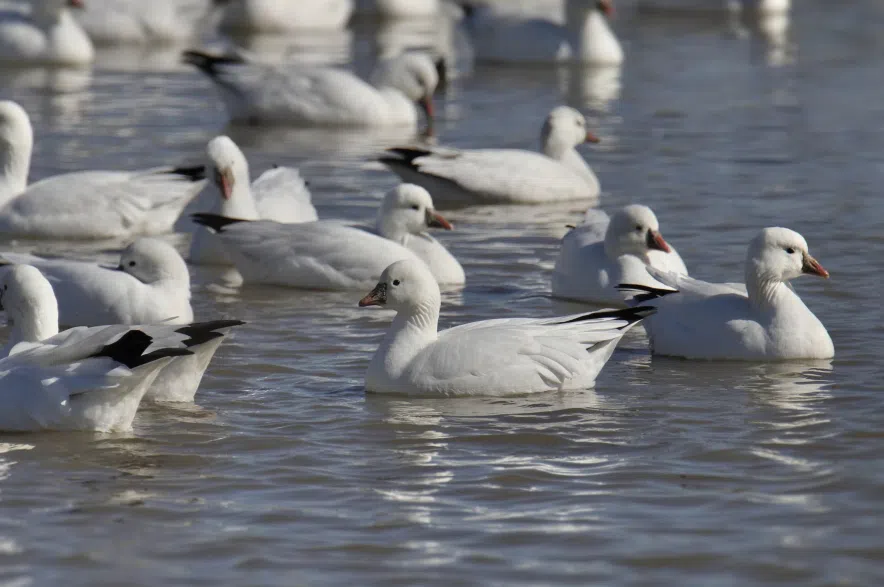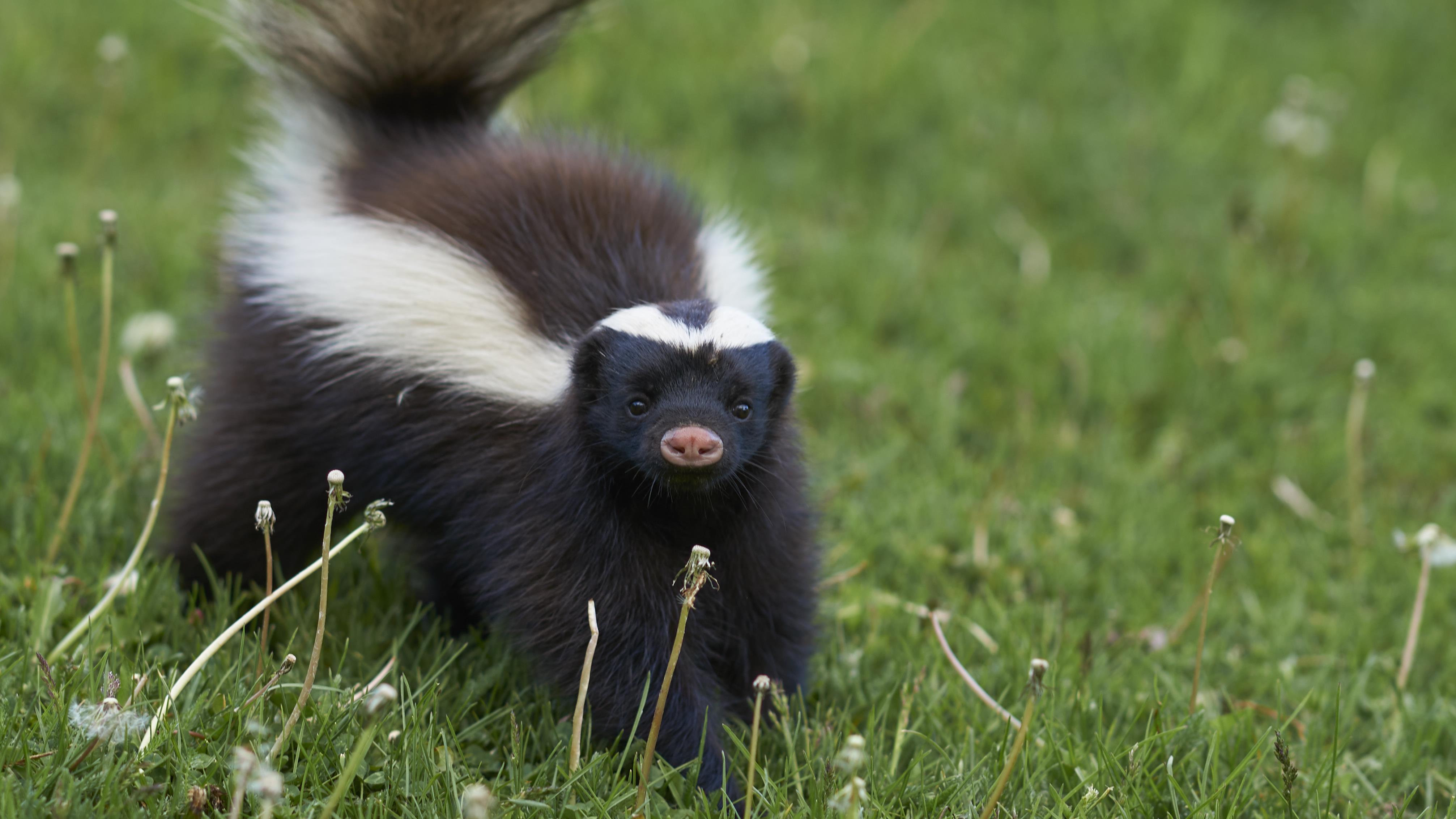bump this
Announcement
Collapse
No announcement yet.
Saskatchewan: Avian flu in wild birds 2022 - 2025
Collapse
X
-
Wildlife rehabilitation centres in Regina, Saskatoon issue warning as bird flu spreads
By Lara Fominoff
May 5, 2025 | 6:00 AM
Saskatoon’s Living Sky Wildlife Rehabilitiation and Regina’s Salthaven West Wildlife Rehabilitation centres are warning the public about handling sick or dead wild birds and mammals as cases of bird flu are on the rise.
Both organizations say they are receiving multiple calls every day about suspected Highly Pathogenic Avian Influenza HPAI (H5N1) in snow geese and Canada geese returning to the province.
Jan Shadick, executive director of Living Sky Wildlife Rehabilitation, said it seems that more snow geese are exhibiting symptoms this year.
“We are definitely getting calls about these birds and it’s not just the geese, because what happens is the virus lives in water quite successfully and so when these birds are migrating through … if there’s one bird on the water, then all the other birds on the water are susceptible,” Shadick explained.
She said it’s not just birds but also predators that are becoming infected with the deadly virus.
“The foxes and the raccoons and the skunks and the coyotes and all of the bird predators — your bald eagles, your hawks, your owls — are eating these carcasses and becoming sick themselves,” Shadick said.
...
Leave a comment:
-
Canada - Influenza A viruses of high pathogenicity (Inf. with) (non-poultry including wild birds) (2017-) - Follow up report 1
GENERAL INFORMATION
COUNTRY/TERRITORY OR ZONE
COUNTRY/TERRITORY
ANIMAL TYPE
TERRESTRIAL
DISEASE CATEGORY
Listed disease
EVENT ID
5582
DISEASE
Influenza A viruses of high pathogenicity (Inf. with) (non-poultry including wild birds) (2017-)
CAUSAL AGENT
Highly pathogenic avian influenza virus
GENOTYPE / SEROTYPE / SUBTYPE
H5N1
START DATE
2024/01/01
REASON FOR NOTIFICATION
Recurrence of an eradicated disease
DATE OF LAST OCCURRENCE
2015/02/04
CONFIRMATION DATE
2024/01/15
EVENT STATUS
On-going
END DATE- SELF-DECLARATION
NO REPORT INFORMATION
REPORT NUMBER
Follow-up report 1
REPORT ID
FUR_166675
REPORT REFERENCE- REPORT DATE
2024/04/12
REPORT STATUS
Validated
NO EVOLUTION REPORT
EPIDEMIOLOGY
SOURCE OF EVENT OR ORIGIN OF INFECTION- Contact with wild species
This event is the continuation of event #4191 for reporting wild birds with high pathogenicity avian influenza (HPAI) H5N1 virus. Outbreaks are reported by province/territory. The geographical marker is on the capital. Outbreaks of HPAI in domestic non-poultry are reported in Event Banks need to think about..... For detailed and current information on high pathogenicity avian influenza cases in wild birds, please consult : http://www.cwhc-rcsf.ca/avian_influenza.php. Wildlife surveillance as well as the Canadian Avian Influenza Surveillance System (CanNAISS) activities for poultry are ongoing in Canada. According to Article 10.4.1.4. of the Terrestrial Animal Health Code, Member Country should not impose bans on the international trade of poultry commodities in response to notification of infection with any Influenza A viruses in birds other than poultry.
QUANTITATIVE DATA SUMMARY
MEASURING UNIT
Animal
SpeciesSusceptibleCasesDeathsKilled and Disposed ofSlaughtered/ Killed for commercial useVaccinated Cooper's Hawk (WILD)NEW-3----TOTAL-3---- Wood Duck (WILD)NEW-1----TOTAL-1---- Northern Pintail (WILD)NEW-1----TOTAL-1---- American wigeon (WILD)NEW-3----TOTAL-3---- Green-winged Teal (WILD)NEW-3----TOTAL-3---- Northern Shoveler (WILD)NEW-1----TOTAL-1---- Mallard (WILD)NEW-10----TOTAL-10---- American Black Duck (WILD)NEW-1----TOTAL-1---- Snow Goose (WILD)NEW-8----TOTAL-15---- Anserinae (unidentified) (WILD)NEW-1----TOTAL-1---- Ross's Goose (WILD)NEW-1----TOTAL-1---- Great Blue Heron (WILD)NEW-1----TOTAL-1---- Canada Goose (WILD)NEW-63----TOTAL-79---- Cackling Goose (WILD)NEW-8----TOTAL-8---- Snowy Owl (WILD)NEW-1----TOTAL-1---- Great Horned owl (WILD)NEW-4----TOTAL-12---- Red-tailed Hawk (WILD)NEW-9----TOTAL-9---- Dunlin (WILD)NEW-1----TOTAL-1---- American crow (WILD)NEW-15----TOTAL-17---- Common Raven (WILD)NEW-1----TOTAL-1---- Blue jay (WILD)NEW-1----TOTAL-1---- Trumpeter Swan (WILD)NEW-3----TOTAL-4---- Peregrin falcon (WILD)NEW-4----TOTAL-4---- Bald Eagle (WILD)NEW-2----TOTAL-2---- Laridae (unidentified) (WILD)NEW-1----TOTAL-1---- Herring Gull (WILD)NEW-4----TOTAL-4---- Glaucous-winged Gull (WILD)NEW-1----TOTAL-1---- Great black-backed Gull (WILD)NEW-1----TOTAL-1---- Double-crested cormorant (WILD)NEW------TOTAL-1---- Black-billed Magpie (WILD)NEW-3----TOTAL-3---- Barred Owl (WILD)NEW-3----TOTAL-3---- Barn Owl (Common Barn-Owl) (WILD)NEW-1----TOTAL-1---- Hooded Merganser (WILD)NEW-1----TOTAL-1---- American goshawk (WILD)NEW------TOTAL-1---- All speciesNEW-161----TOTAL-197----
DIAGNOSTIC DETAILS
CLINICAL SIGNS
NO
METHOD OF DIAGNOSTIC
Diagnostic testNEW OUTBREAKSGene sequencing National Centre for Foreign Animal Disease (NCFAD), Winnipeg, Manitoba Great Horned owl,Snow Goose,Mallard,Ross's Goose,Cackling Goose,Herring Gull,Northern Shoveler,Black-billed Magpie,Red-tailed Hawk,Great Blue Heron,Great black-backed Gull,Glaucous-winged Gull,Dunlin,Bald Eagle,Barn Owl (Common Barn-Owl),Snowy Owl,Peregrin falcon,Laridae (unidentified),Barred Owl,Hooded Merganser,Common Raven,Anserinae (unidentified),Canada Goose,Blue jay,American Black Duck,Wood Duck,Double-crested cormorant,American wigeon,Trumpeter Swan,American goshawk,Northern Pintail,Green-winged Teal,American crow,Cooper's Hawk 10 2024/01/15 2024/03/28 Positive Real-time reverse transcription polymerase chain reaction (rRT-PCR) National Centre for Foreign Animal Disease (NCFAD), Winnipeg, Manitoba Common Raven,Dunlin,Peregrin falcon,Anserinae (unidentified),Barn Owl (Common Barn-Owl),Hooded Merganser,Cooper's Hawk,Snow Goose,Wood Duck,Green-winged Teal,Canada Goose,American crow,Northern Pintail,Glaucous-winged Gull,Barred Owl,Red-tailed Hawk,Great Horned owl,American goshawk,Laridae (unidentified),American Black Duck,American wigeon,Cackling Goose,Mallard,Double-crested cormorant,Ross's Goose,Northern Shoveler,Black-billed Magpie,Trumpeter Swan,Herring Gull,Great Blue Heron,Snowy Owl,Great black-backed Gull,Blue jay,Bald Eagle 10 2024/01/15 2024/03/28 Positive
OB_133570 - NL-2024-HPAI-WB-1 - NEWFOUNDLAND AND LABRADOR - WILDBIRDS
OB_133569 - NS-2024-HPAI-WB-1 - NOVA SCOTIA - WILDBIRDS
OB_133568 - SK-2024-HPAI-WB-1 - SASKATCHEWAN - WILDBIRDS
OB_133567 - NB-2024-HPAI-WB-1 - NEW BRUNSWICK - WILDBIRDS
OB_133566 - BC-2024-HPAI-WB-1 - BRITISH COLUMBIA - WILDBIRDS
https://wahis.woah.org/#/in-review/5582
Leave a comment:
-
Translation Google
Suspected cases of bird flu in foxes and skunks
Skunks may have died of bird flu in Saskatchewan.
Radio Canada
at 7:15 a.m.
Possible cases of bird flu have emerged in mammals in Saskatchewan, according to pathologist at the Western Veterinary College in Saskatoon, Trent Bollinger.
According to him, the first suspected case of bird flu in a large carnivore was brought to his laboratory three weeks ago.
As of last week, between 6 and 10 other animals had been tested.
It was mostly skunks, as well as a red fox, that showed neurological signs that could be attributed to avian flu , he says.
Trent Bollinger notes that other viral illnesses cause similar symptoms, such as distemper or rabies.
However, recent molecular diagnostic tests point to avian flu as the most likely cause in at least three of the deaths analyzed.
In other cases, we have done autopsies and we are continuing the analyses. There could therefore be more cases , specifies the veterinary pathologist.
The transmission of the virus to mammals does not surprise the specialist. Cases have also appeared in the United States, he says. But we have quite a few, which may be a little unusual. That remains to be seen.
Deaths throughout the summer
Trent Bollinger expects more waterfowl to die from bird flu over the summer, as the risk of transmission is high in these bird species.
There were a large number of dead birds in the spring, during the migration season. But while the specialist expects the mortality of these birds to decrease during the summer, he notes that the baby birds are however another group at risk.
We will have new cohorts of ducklings and juvenile birds that could also be exposed to the virus, he says. So we could see yet again an increase in the number of dead birds observed by the public.
According to Trent Bollinger, the species most affected by the virus seem to be in relatively high numbers, and the mortality rate does not currently have a significant impact on their populations.
What is especially worrying is the risk of transmission to poultry, because then the birds die in large numbers and the virus has economic impacts , he recalls.
The veterinarian is reassuring: the virus of this flu is not transmitted to dogs, cats and humans.
What to do
Trent Bollinger reminds you to avoid touching animals whose behavior is not normal, and contact a wildlife conservation officer.
If the animal in question dies and avian flu may be the cause, Trent Bollinger says the carcass can be picked up wearing latex gloves, put in a plastic bag and taken to a lab, like that of the College of Veterinarians.
With information by Daniella Ponticelli
Leave a comment:
-
Source: https://ca.news.yahoo.com/presumptiv...100000527.html
Presumptive cases of avian flu in skunks, foxes found in Sask.
Sun, May 29, 2022, 6:00 a.m.·2 min read
Presumptive cases of avian flu are showing up in some species of mammals in Saskatchewan.
Trent Bollinger is a wildlife pathologist at the Western College of Veterinary Medicine in Saskatoon.
He told CBC News the first presumptive case of avian flu in a "major carnivore" came into the lab about three weeks ago.
As of the last week, six to ten more have been tested.
"These are primarily skunks, with the occasional red fox, that have neurological signs which could be attributed to (high pathogenic) avian influenza virus," he said.
Bollinger noted there are other viral diseases — such as distemper and rabies — that cause similar symptoms in these species...
Leave a comment:
-
Source: https://regina.ctvnews.ca/extra-vigi...reak-1.5859247
'Extra vigilant': Sask. poultry farmers increase safety measures in light of avian flu outbreak
Allison Bamford
Video journalist at CTV News Regina
Updated April 12, 2022 8:21 p.m. EDT
Published April 12, 2022 4:27 p.m. EDT
Deadly avian influenza has been detected in Saskatchewan for the first time in 15 years.
A snow goose near the town of Elrose, around 320 km northwest of Regina, was found to have the “highly pathogenic” H5 strain of avian influenza (HPAI) by the Canadian Food Inspection Agency.
Veterinary pathologist Trent Bollinger performed the autopsy in Saskatoon.
Since then, he said his lab at the University of Saskatchewan has done tests on upwards of 50 birds believed to have died from HPAI. The number of unreported deaths is even higher, he said...
Leave a comment:
-
Saskatchewan: Avian flu in wild birds 2022 - 2025
Source: https://www.sasktoday.ca/central/loc...chewan-5248265
Avian influenza detected in Saskatchewan
The last time HPAI was found in Saskatchewan in either commercial poultry or wild birds was in 2007
SASKTODAY.ca
about an hour ago
REGINA — Samples collected from a snow goose found near Elrose have been confirmed positive for HPAI by the Canadian Food Inspection Agency.
The Ministry of Agriculture is reminding poultry producers with flocks of all sizes to follow all necessary biosecurity protocols to keep their flocks free of diseases after a highly pathogenic avian influenza (HPAI) H5 strain was detected in a wild bird in Saskatchewan.
The confirmation of the strain in the Saskatchewan bird follows the detection of HPAI in poultry and wild birds in the United States and in several Canadian provinces.
The last time HPAI was found in Saskatchewan in either commercial poultry or wild birds was in 2007...Tags: None

;Composite=(type=URL,url=https://images.radio-canada.ca/v1/assets/elements/16x9/outdated-content-2022.png),gravity=SouthEast,placement=Over,location=(0,0),scale=1)
Leave a comment: